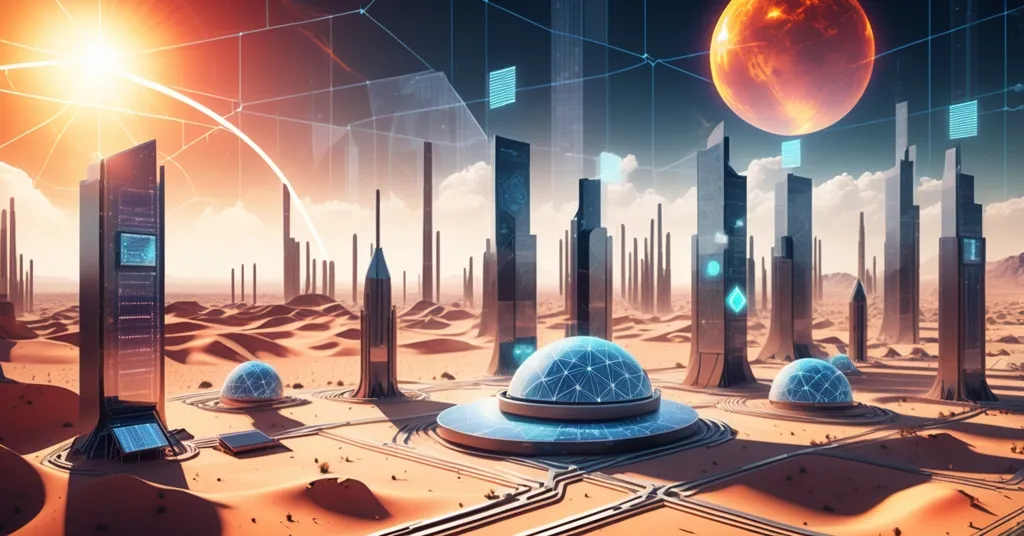Humain’s 6-Gigawatt Data Center and AI OS: Saudi Arabia’s Bold Tech Gamble

Humain’s 6-Gigawatt Data Center Plan and Next-Gen OS: A Tech Titan in the Making?
Saudi Arabia is throwing down the gauntlet in the global tech arena with Humain, a homegrown AI company, announcing a jaw-dropping 6-gigawatt data center project and a revolutionary operating system called Humain 1. Revealed by CEO Tareq Amin at the Fortune conference in Riyadh, these moves signal the Kingdom’s unyielding ambition to become a powerhouse in AI and computing infrastructure, challenging the status quo of tech giants worldwide.
- Mega Infrastructure: 6 gigawatts of data center capacity to drive AI innovation.
- Humain 1 OS: A bold shift to natural language and AI agent-driven computing.
- Nvidia Alliance: AI factories powered by cutting-edge tech for industrial transformation.
The 6-Gigawatt Behemoth: Powering Saudi Arabia’s Tech Dreams
Let’s start with the sheer scale of this endeavor. Humain’s plan to build 6 gigawatts of data center capacity is not just ambitious—it’s a seismic shift. To put this into perspective, one gigawatt can power around 750,000 homes. Multiply that by six, and you’ve got a computing juggernaut that dwarfs many existing facilities—Google’s largest data centers, for comparison, often operate at a fraction of this capacity. This isn’t just about raw power; it’s about creating the backbone for massive AI operations, positioning Saudi Arabia as a serious contender in the global tech race. As Tareq Amin stated during his announcement:
“The project aims to strengthen Saudi Arabia’s position in technology and large-scale computing capabilities.”
This aligns directly with Saudi Arabia’s Vision 2030, a national blueprint to diversify beyond oil and build a tech-driven economy. If executed right, these data centers could turn the Kingdom into a regional hub for artificial intelligence, rivaling the likes of Silicon Valley or Shenzhen. But let’s not sip the Kool-Aid just yet. Building something of this magnitude is a logistical minefield. We’re talking astronomical energy demands, cooling challenges in a desert climate, and potential environmental fallout. If Humain doesn’t nail the execution, this could become a multi-billion-dollar white elephant. And speaking of energy, how will they power this beast? Saudi Arabia has vast solar potential—will they harness renewables, or fall back on fossil fuels and face a PR shitstorm hotter than the desert sun?
Humain 1 OS: A Revolution in How We Compute—or a Privacy Nightmare?
Equally intriguing, and perhaps more disruptive, is Humain 1, a next-generation operating system that throws out the rulebook. Forget windows, icons, and apps. This OS pivots to an “agent-first approach,” where AI agents handle tasks through natural language interactions. For the uninitiated, natural language processing (NLP) is the tech behind tools like Siri or ChatGPT, enabling machines to understand and respond to human speech or text. With Humain 1, you’d simply tell your device what you want in plain language—say, “book me a flight to Dubai”—and the AI agent does the rest. No menus, no clicks, just conversation. If this works as promised, it could make tech absurdly intuitive, especially for folks who struggle with traditional interfaces.
But here’s the devil’s advocate take: who’s listening to those commands? Every time you chat with your device, where’s that data going? Is it processed on-device, or shipped off to some cloud server in who-knows-where? Privacy scandals like Amazon’s Alexa eavesdropping debacles loom large here. Humain will need ironclad safeguards—think end-to-end encryption or localized data storage—to avoid turning this innovation into a surveillance tool. For us decentralization advocates, this raises red flags. Could a blockchain-based identity system secure these interactions? It’s a long shot, but worth pondering.
Hardware for the Masses: Accessibility with a Catch
Humain isn’t stopping at software or infrastructure—they’re also rolling out hardware to democratize access. They’ve unveiled an AI agent-powered computer designed to slash costs, targeting educational use, alongside the Horizon Pro laptop, built on the Snapdragon X Elite platform. This laptop sips power like a camel in the desert—let’s just hope it doesn’t spit out bugs too. To test the waters, Humain plans to distribute 500 Horizon devices to students in a pilot program. It’s a savvy move in a country with a young, tech-hungry population, potentially fostering a new generation of digital natives.
Still, pilot programs are the easy part. Scaling to millions while maintaining quality, affordability, and support? That’s where dreams often crash into reality. If the user experience flops or the hardware can’t keep up with Humain 1’s AI demands, this could end up as just another tech pipe dream. And let’s not ignore the digital divide—lowering costs is noble, but if adoption isn’t inclusive, this risks benefiting only the elite, leaving rural or low-income communities in the dust.
Nvidia Partnership: AI Factories and the Industrial Edge
Humain isn’t flying solo—they’ve roped in Nvidia, the heavyweight champ of GPU technology, to build AI factories in Saudi Arabia. We’re talking a planned capacity of 500 megawatts, fueled by hundreds of thousands of Nvidia GPUs over the next five years. The initial setup includes an 18,000 NVIDIA GB300 Grace Blackwell AI supercomputer with InfiniBand networking—a high-speed connection tech that links components for lightning-fast data transfer. For those new to the jargon, GPUs (graphics processing units) are the workhorses of AI, crunching massive datasets for training models or running simulations, while supercomputers like Grace Blackwell deliver mind-bending processing power.
Nvidia’s Omniverse platform is also in play, enabling digital twins—virtual replicas of real-world systems—for sectors like manufacturing, logistics, and energy. This is Industry 4.0, the fourth industrial revolution, where smart tech like AI and IoT (Internet of Things) transforms how we build and operate. Picture a Saudi factory running a digital twin to perfect every process before touching a single machine. It’s a game-changer for productivity and sustainability. But let’s not get too starry-eyed—can Saudi Arabia’s regulatory environment and infrastructure keep pace with this tech tsunami? Historical hiccups in large-scale projects suggest this won’t be a smooth ride.
Global AI Arms Race: Saudi Arabia Joins the Fray
Zooming out, Humain’s moves fit into a broader global scramble for AI dominance. Nvidia’s recent $100 billion partnership with OpenAI to build 10-gigawatt data centers—equivalent to 4-5 million GPUs—sets the bar sky-high. Nvidia CEO Jensen Huang called it bluntly:
“This is a giant project… monumental in size.”
Humain’s 6-gigawatt plan, while smaller, echoes this urgency. Saudi Arabia is signaling it won’t be a bystander in the AI revolution. Yet, playing catch-up with titans like the U.S. and China, who’ve got years of talent and ecosystem advantages, is no small feat. Throw in geopolitical tensions—tech is a new battlefield—and you’ve got a recipe for either stunning success or spectacular failure. Will Humain’s gamble pay off, or is this too much, too soon? For more details on Humain’s ambitious 6-gigawatt project and innovative OS, their announcement paints a bold vision.
AI and Blockchain: A Decentralized Future with Humain?
As champions of decentralization, we can’t help but wonder how Humain’s infrastructure intersects with cryptocurrency and blockchain. Could these data centers use excess power for Bitcoin mining, especially if renewables are tapped? It’s not far-fetched—other major facilities have done it, balancing energy waste with profit. Or consider decentralized AI: protocols like Filecoin for storage or Render Token for GPU-sharing show how blockchain can democratize computing resources. Imagine Humain hosting decentralized AI models on a blockchain for transparency—now that’s the kind of disruption we’d root for.
From a Bitcoin maximalist lens, though, there’s skepticism. Humain’s centralized AI push feels at odds with the ethos of permissionless systems. Bitcoin doesn’t need AI agents; it’s already the ultimate middleman-killer. Still, I’ll concede that altcoins and platforms like Ethereum, with smart contracts and DAOs (decentralized autonomous organizations), could bridge AI and crypto better. Maybe Humain’s factories become testbeds for such experiments. No concrete plans exist yet, but the potential is tantalizing.
Socioeconomic Stakes and Sustainability Challenges
Beyond tech, the socioeconomic ripples of Humain’s plans are massive but murky. On one hand, AI factories and data centers could create thousands of high-skilled jobs—estimates for similar projects suggest a 6-gigawatt operation might employ 5,000-10,000 workers directly and indirectly. That’s a boon for Saudi Arabia’s economy and talent pool. On the other, there’s a real risk of widening inequality if benefits don’t reach beyond urban elites. Tech literacy programs and inclusive access will be critical, or this becomes a shiny toy for the few.
Then there’s the energy elephant. A 6-gigawatt operation guzzles power like there’s no tomorrow. Microsoft and Amazon have tackled similar challenges with renewable mixes—think solar farms and wind power. Saudi Arabia’s desert sun could be a goldmine for solar energy, but if Humain leans on fossil fuels instead, they’ll face global backlash. For us in the crypto space, sustainable energy isn’t just greenwashing—it’s practical. Renewable-powered data centers could mine Bitcoin without the carbon guilt, a debate raging in our community. Humain’s silence on this front so far is deafening.
Key Takeaways and Burning Questions
- What does Humain’s 6-gigawatt data center mean for Saudi Arabia’s tech ambitions?
It’s a colossal leap toward making the Kingdom a regional AI hub, supporting Vision 2030’s goal to pivot from oil to tech, though execution risks loom large. - How does Humain 1 OS differ from traditional systems?
It swaps apps and icons for a natural language interface with AI agents, aiming for intuitive use but sparking serious privacy concerns. - Why is Nvidia’s partnership pivotal for Humain?
Nvidia’s GPUs, supercomputers, and Omniverse platform provide the muscle for AI factories, driving industrial innovation through digital twins and beyond. - Can Saudi Arabia rival global AI leaders with this initiative?
The scale and partnerships are promising, but catching up to the U.S. and China demands flawless strategy amidst infrastructure and regulatory challenges. - Could Humain’s infrastructure fuel crypto and blockchain innovation?
There’s untapped potential—think Bitcoin mining with excess power or hosting decentralized AI on blockchain—though no direct plans have surfaced yet. - What are the sustainability risks of a 6-gigawatt operation?
Energy consumption is a massive hurdle; without renewables like solar, Humain risks environmental and PR disasters, a concern echoing crypto’s mining debates.
Humain’s bold vision could crown Saudi Arabia an AI kingpin, or bury it under a desert of debt and dead tech. We’re rooting for disruption and decentralization, especially if there’s even a whisper of crypto synergy in these data centers. But ambition alone isn’t enough—execution, ethics, and energy strategy will make or break this gamble. What’s your bet on Humain’s future?



